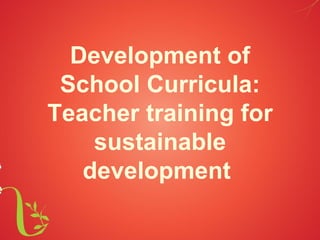
Development of school curricula sunum2
- 1. Development of School Curricula: Teacher training for sustainable development
- 2. ERTUGRUL GAZI PRIMARY SCHOOL
- 3. • Our school is located in the Istanbul district Sultanbeyli in the Asian side of İstanbul - 12 million people - out of which its 360.000 inhabitants live in Sutanbeyli.
- 4. • Our school has 1400 students. It consists of a kindergarten (age 5-6 ) plus two additional separate parts , the primary level including grades 1 to 5, and the secondary level including 6 to 8 grades.
- 5. • Our pupils age: 7-14. Besides, our school has classes for students with special needs. Pupils' parents are usually migrants to Sultanbeyli coming from all parts of Turkey looking for employment. They are of low educational, economic and social levels and are employed mainly in construction and textile industries.
- 6. Our goal • Our goal is: to contribute to the growing up of the young generations of disadvantaged parents to be trained to understand the importance of education for their sustainable development
- 7. • and the development of their country through international projects and cooperation in education.
- 8. Our role • Our role in the project: a) tocombat exclusion and increase equal opportunities level in the school and local community;
- 9. • b) to foster "education for all" principle with developing teaching materials to satisfy student's needs;
- 10. • c) to provide & promote the use of new technologies in teaching process for the disadvantaged groups;
- 11. • d) to attract and increase parents' collaboration with the school;
- 12. • e) to introduce the topic of sustainable development on the everyday school agenda.
- 13. • To obtain the parents’ collaboration with the school; we have festivals from time to time to acquire money for needs of students. Parents help us have and prepare festivals.
- 14. • To foster ‘education for all’ principle; We have seminars for parents and students.These seminars are about health and education and understanding each other.
- 15. • We have Social benefits. We collect money, clothes,etc. as needed and give parents in need.
- 16. • There are a few parents that cannot read or write. They can’t help their children while they are studying their lessons. That is why we have courses for illiterate parents, carried out by our teachers. After courses, after learning writing and reading, they can help their students and they feel themselves happy
- 17. • We have a project called “Be My Tutor”. The students who are successful and eager to learn help the students who have some difficulties in learning. They are our small teachers and teachers’ helpers. The project brings about the progress for all the students.
- 18. • Also there are training courses for parents at weekends such as computer courses.
- 19. Our parents have school trips. There are historical and educational trips.
- 20. For environmental education ; Our parents and students contribute to our school project, “Battery Collection”. They all bring dead batteries to school and we collect and deliver them to the Municipality. Every school tries to do this project.
- 21. • We will create an art corner by using waste materials. Moreover, an art exhibition about environment and awereness will take place in our school.
- 22. To protect the environment, it is necessary to educate people and students as individuals who have environmental awareness and knowledge to environmental subjects.
- 23. Environmental education has an important role in order to take growing up sensible generation’s attention to environmental problems.
- 24. • To develop Environmental awareness; we should have Ecology lesson at schools. There is not such a course like this in the curricula of the Ministry of Education in Turkey. However, we think there should be in order to enhance students’ environmental awareness.
- 25. We should have corners of plants, and farming and greens,
- 26. • and animals.
- 27. About Environment the main themes are; 1.Responsibilty. 2.Sharing/Caring. 3.Helping.
- 28. • About our lessons, education system;
- 29. • In our lessons we try to integrate the four main skills: reading, listening, writing and speaking.
- 30. • We try to use Communicative Method to develop students' speaking abilities and lower down the level of speaking anxiety by reinforcing every effort students make during the lessons or outdoor activities.
- 31. • The Total Physical Response (TPR) is a method that we apply most as the students' ages differ from 9 to 14 and they can learn easily through games requiring physical exercises.
- 32. To attract learners' attention and initiate student motivation, we use realias, flashcards, puppets and every material we find in the classroom to trigger their imagination.
- 33. • Such as;
- 34. As communication is the main goal of acquiring a language, we apply role-play activities and dramas to enhance speaking skills and to check learners' pronunciation.